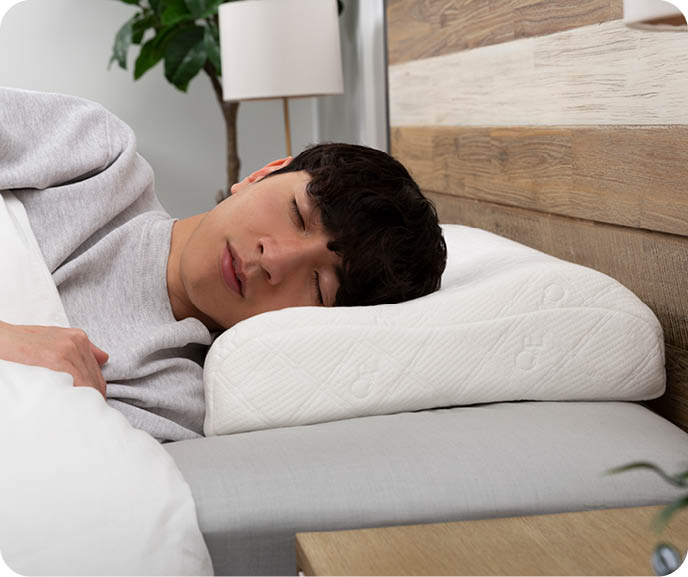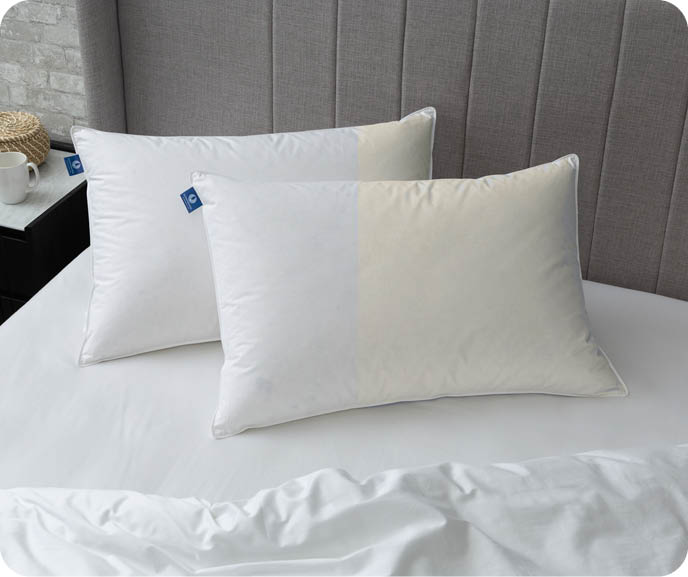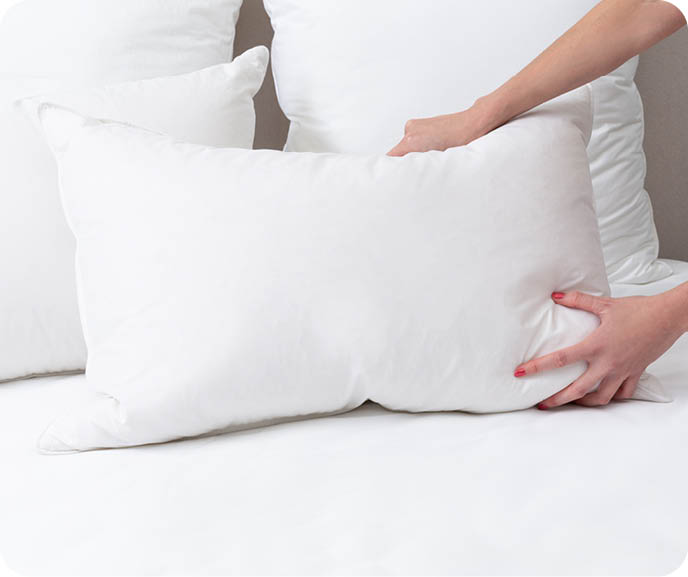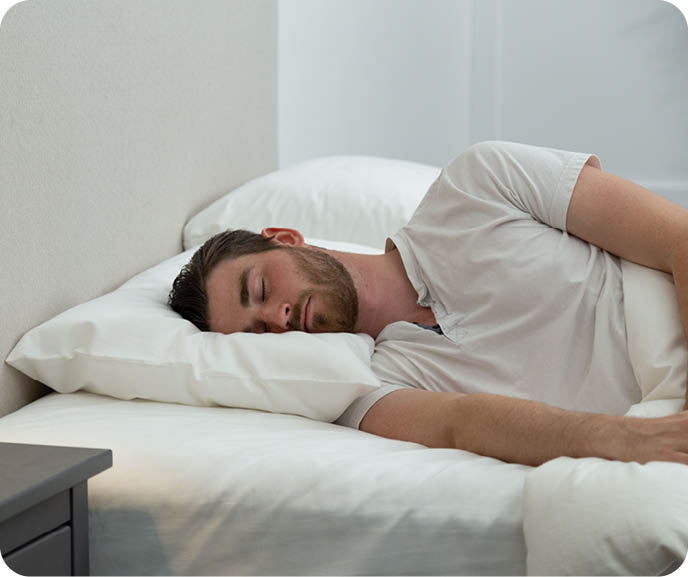How To Wash Your Pillows Perfectly Every Time
2024 Jan 4th
Want your pillows to stay fresh, clean, and oh-so comfortable? Unlike other bed linens, proper pillow hygiene is not as straightforward as a casual toss in the laundry machine. That’s why we’ve created a guide to teach you how to wash your pillows like a pro and keep them in great shape for years to come.

From machine-washing and hand-washing to spot-cleaning and more, these care tips will help you cleanse any type of pillow or cushion. So get ready to rest and refresh your weary head(rest) with confidence.
But first, some basics…
Why Should You Wash Your Pillows?
With a whole laundry list of to-dos, it’s easy to overlook the importance of pillow washing. But be warned: while bathing these bedmates might seem like a forgettable chore, pillow hygiene actually plays a crucial role in maintaining a healthy and happy sleep environment.
You see, pillows accumulate more than just the impressions of a good night's sleep. Over time, these headrests become home to dust mites, bacteria, dead skin cells, sweat, oils, makeup, and skin care products. And these resulting residues (and residents) can trigger allergies, skin irritations, or even respiratory issues.
(Not-so-fun fact: a yellowing pillow is a clear visual indicator of excessive oil and sweat build-up. Yuck!)

So think of regular pillow-washing as a meaningful investment in your well-being. It not only removes the risk of these potential health hazards, but revitalizes your pillow and ensures you’ll have what you need to sleep soundly.
Related: How to Remove Pesky Oil Stains From Your Bed Sheets
How Often Should You Wash Pillows?
While it’s best practice to wash the rest of your bedding — i.e. your sheets, duvet covers, and pillowcases — every week or so, pillows have a bit more leeway. You should aim to wash or tend to your pillows every 4-6 months.
Additionally, using a pillow protector is always recommended, as this will extend the life and cleanliness of your pillow, giving you more time between washes.
How To Wash Pillows In A Washing Machine
The easiest way to wash a pillow or insert is, of course, using a washing machine. But there are a few things to remember before you start your automated scrub-a-dub journey.
Here are step-by-step instructions for washing your pillows by machine:
- Confirm the pillow is machine washable: The good news is, many pillows and cushion inserts can be washed easily and effectively by machine — but be sure to consult the care instructions first! For example, QE Home’s down filled pillows, natural alternative (i.e. kamboo) filled pillows, and synthetic (i.e. microgel) filled pillows are all safe to be washed this way.
Note: Do not machine-wash memory foam and silk filled pillows. While you can probably wash their outside covering by machine, any memory foam insert should be hand-washed only. Silk pillows don’t fare well either, as their fine fibers can clump if washed.
- Separate and balance your loads: Always wash pillows in a separate load from your other linens or clothing. We also strongly recommend washing only two pillows at a time to ensure they get cleaned thoroughly. This also keeps you from putting excessive strain on the machine, as pillows can grow quite heavy in the wash and cause damage if the load is too big.
- Place your pillows according to machine type: Front-loading or top-loading machines without agitators are preferable, but it’s not the end of the world if you don’t have one. For top-loading machines with agitators, place your pillows vertically in the barrel to reduce the chance of damage.
- Use a gentle cycle: Select a gentle or delicate cycle with a slow spin speed to prevent the pillows from becoming misshapen or damaged during the washing process.
- Opt for a mild, bleach-free detergent: Use a mild detergent to lower the risk of having leftover residue. You should also avoid using too much of any detergent, as certain pillows can be quite absorbent and hard to rinse out completely.
- Rinse thoroughly: After completing the washing cycle, it’s a good idea to run an extra rinse cycle to ensure all detergent is cleansed away.
- Dry carefully: Depending on the pillow type, you may be able to tumble dry them on a low heat setting. Note that some pillows (like those with silk or memory foam filling) are better suited for air-drying in order to maintain their shape and integrity.
Tip: Adding a clean, dry towel can help reduce the drying time needed.
Again, always check the care instructions to avoid damage. And when in doubt, you can always take a more manual route.
How To Hand Wash Pillows
While hand-washing does require more energy, attention, and care, this method ensures the cleanliness of your plush headrests or decorative pillows while protecting against damage that a machine might otherwise cause.
Here is a step-by-step guide to hand-washing your pillows:
- Check the Care Instructions: Before starting the process, look over the care label. Some pillows have specific cleaning instructions and may not be suitable for hand washing (for example, silk pillows should be spot-cleaned at most).
- Prepare Your Washing Solution: Next, fill a basin or bathtub with lukewarm water. Add a small amount of mild detergent, ensuring it’s completely dissolved before soaking. Don’t use fabric softeners or bleach-based products, as this can damage fibers.
- Submerge and Soak the Pillows: Place the pillows in the soapy mixture and fully submerge them. Allow the solution to penetrate all the fibers of the shell, then let your pillows soak for at least 20 minutes to loosen dirt, oils, and odours.
- Gently Hand Wash: After 20 minutes, agitate (shake) the pillows in the water, paying extra attention to any stains or soiling. To tackle those tricky spots, spot-clean with a soft brush or cloth.
- Drain and Refill: Once you’re satisfied, drain the soapy water and refill the basin/bathtub with clean, lukewarm water for rinsing. Apply pressure to your pillows to remove excess soap.
- Rinse and Squeeze Out Excess: Repeat the draining and rinsing process until the water runs clear and free from suds, then gently squeeze out any remaining water from the pillows by applying pressure. Do not wring them out, as this can damage the pillow fill.
- Reshape and Air Dry Thoroughly: Lay the pillows on a clean, dry towel and reshape them to their original form. Using a well-ventilated (or sunny) area is best to ensure complete dryness.

Other Ways To Wash Your Pillows
Spot Cleaning
If you don’t want to subject the entire pillow to a wash, spot cleaning is a specific type of hand washing that can help address specific stains. This method can be used on virtually any kind of pillow, although — you guessed it — it’s important to check the care instructions first.
Here's a step-by-step guide for spot cleaning a pillow:
- Identify the Stain: Determine the nature of the stain, as this will inform your cleaning approach (e.g. water temp) to use.
- Blot the Stain: Gently blot the stain with a cloth or sponge to help it release from the fibers. Don’t rub it, as this can push the stain deeper into the fabric.
- Prepare a Cleaning Solution: Mix a small amount of mild, bleach-free detergent with water to create a soapy mixture.
- Spot Clean: Dip your damp cloth or sponge in your cleaning solution, and start gently dabbing the area, working from the outer edges of the stain toward the center to prevent it from spreading.
- Rinse with Water: Rinse the cloth or sponge and blot the treated area with plain water to remove any soap residue. Again, blot — don't rub.
- Dry the Area: Pat with a dry towel to absorb excess moisture. Allow the pillow to air dry thoroughly before putting it back on your bed.
Sun Curing
A major benefit of silk pillows is that they almost never require cleaning (when used with a pillow protector or cover), since silk naturally repels dust mites and absorbs less moisture. Instead, they can be “sun-cured” — a process that involves airing out in the sun for a couple of hours per year.
Tip: Use a silk pillowcase to achieve the beauty sleep-boosting benefits of silk on any pillow.
Washing Your Pillows FAQ
Can you put pillows in front-loading washing machines?
Yes, you can absolutely wash pillows in front-loading washing machines! In fact, front-loading machines are preferable for machine washing, as they’re generally more gentle on items compared to top-loading machines with an agitator.
Always follow the specific instructions provided on your pillow’s packaging to ensure proper care.
What detergents should you use when cleaning pillows?
When cleaning pillows, it's important to use a mild detergent, as this will minimize the chance of any leftover residues irritating your skin or impacting the pillow's quality.
Opting for an unscented or natural detergent option (such as Tru Earth Laundry Detergent Strips) is smart, as these products are typically free from harsh chemicals and fragrances.
Just be sure to steer clear of fabric softeners and bleach, as they can affect the pillow's fluffiness and damage the fabric/filling.
Will pillows flatten after being washed?
The impact washing has on a pillow’s fluffiness — or loft — depends on the pillow fill type. For example, while down/feather pillows may initially lose some loft after washing, they can usually be restored to their former glory with proper fluffing and drying. The same applies for pillows made with other natural fiber fills like kapok.
(Tip: QE Home uses high-quality, certified down in all our down filled products. Read more about our certifications here.)
A caveat to this category is silk pillows, which are best left out in the sun to freshen (a practice known as “sun-curing”) or spot-cleaned in the case of small stains. Meanwhile, memory foam pillows should exclusively be hand-washed only to preserve the foam’s integrity.
As always, make sure to follow the care instructions provided!
How to know when to replace your pillows?
Experts recommend replacing pillows every 1 to 2 years for optimal support, cleanliness, and allergen-free sleep. Signs for replacement include waking up with a sore neck, discomfort finding a comfortable sleeping position, sagging, lumps, excessive yellowing, or increased allergy symptoms at night. Proper care is crucial for pillow longevity. Polyester pillows last 6 months to 3 years, down and feather pillows last 1 to 3 years, and memory foam pillows are the most durable, lasting 2 to 3 years.
Can you use new pillows right away?
While new pillows and filled cushions are generally ready for use immediately, it doesn’t hurt to let them air out for a few hours first — especially if they’ve been tightly packed or wrapped in plastic. Giving them time to breathe allows any odours to dissipate before you rest and lean on them.
While you’re at it, you should fluff any new pillows before setting them down, as this helps restore their shape if they were compressed. Simply give them a good shake to distribute their filling.

With all that pillow talk out of the way, we hope you’re feeling ready to get your cushion cleaning on!
Want more tips and tricks to achieving a spotless slumber? You can always ask our experts if you have any questions about caring for your pillows, or check out our linen laundering and fabric care page to learn how to wash your bedding like a pro. And for a daily dose of napping know-how (not to mention, dreamy deals), subscribe to our newsletter.

